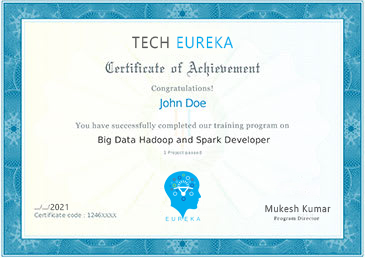

This Big Data Hadoop Developer Certification training program provides online training on the popular skills required for a successful career in data engineering. Master the Hadoop Big Data framework, leverage the functionality of Apache Spark with Python, simplify data lines with Apache Kafka and use the database management tool Hbase to store data.
Determining Memory Consumption
Micro batch
Discretized Streams (DStreams)
Input DStreams and Receivers
Dstream to RDD
Basic Sources
Advanced Sources
Transformations on DStreams
Output Operations on DStreams
Design Patterns for using foreachRDD
DataFrame and SQL Operations
Checkpointing
Socket stream
File Stream
Stateful operations
How stateful operations work?
Window Operations
Join Operations
How to process late arriving data?
What is called watermark?
Hands On:
Writing code for Creating SparkContext , HiveContext and HbaseContext objects
• Writing code for Running Hive queries using Spark-SQL
• Writing code Loading , transforming text file data and converting that into Dataframe
• Writing code Reading and storing JSON files as Dataframes inside the spark code
• Writing code for Reading and storing PERQUET files as Dataframes
• Reading and Writing data into RDBMS (MySQL for example) using Spark-SQL
• Caching the dataframes
• Writing code for Processing Flume data using Spark streaming
• Writing code for Processing network data using Spark streaming
• Writing code for Processing Kafka data using Spark streaming
• Writing code for Storing the output into HDFS using Spark streaming
Unsupported Hive Functionality
Evolution of distributed systems
Why we need new generation of distributed system?
Limitation with Map Reduce in Hadoop,
Understanding need of Batch Vs. Real Time Analytics
Batch Analytics - Hadoop Ecosystem Overview, Real Time Analytics Options
Introduction to stream and in memory analysis
What is Spark?
A Brief History: Spark
Using Py-Spark for creating Spark Application
Invoking Py Spark Shell
Creating the SparkContext
Loading a File in Shell
Performing Some Basic Operations on Files in Spark Shell
Building a Spark Project with maven
Distributed Persistence
Spark Streaming Overview
Example: Streaming Word Count
Shared Variables: Broadcast Variables
Shared Variables: Accumulators
HBase Data Model,
HBase Shell,
HBase Client API,
Data Loading Techniques,
ZooKeeper Data Model,
Zookeeper Service,
Zookeeper,
Demos on Bulk Loading,
Getting and Inserting Data,
Filters in HBase.,
Creating Hbase tables and column families
• Writing code for Loading data into Hbase table
• Writing codefor Performing CRUD operations in Hbase
• Creating external table in Hive for integrating Hbase with Hive
• Writing code for Loading data into Hbase using MapReduce
• Writing code for Creating Hbase tables and column families
Here we will learn different data loading options available in Hadoop and will look into details about Flume and Sqoop to demonstrate how to bring various kind of files such as Web server logs , stream data, RDBMS, twetter ‘s tweet into HDFS.
Hive Background
Hive Use Case
About Hive
Hive Vs Pig
Hive Architecture and Components,
Metastore in Hive
Limitations of Hive
Comparison with Traditional Database
Hive Data Types and Data Models
Static and Dynamic Partitions
Buckets
Hive Tables(Managed Tables and External Tables)
Importing Data, Querying Data, Managing Outputs
Hive Script
Hive UDF
Hive Demo on Healthcare and Airline Data set.
What MapReduce is and why it is popular
• The Big Picture of the MapReduce
• MapReduce process and terminology
• MapReduce components failures and recoveries
• Working with MapReduce
• Lab: Working with MapReduce
Day 2
• Java MapReduce implementation
• Map() and Reduce() methods
• Java MapReduce calling code
• Lab: Programming Word Count
Input/Output Formats and Conversion Between Different Formats
• Default Input and Output formats
• Sequence File structure
• Sequence File Input and Output formats
• Sequence File access via Java API and HDS
• MapFile
• Input Format Classes
• Format Conversion
MapReduce Features
• Joining Data Sets in MapReduce Jobs
• How to write a Map-Side Join
• How to write a Reduce-Side Join
• MapReduce Counters
• Built-in and user-defined counters
• Retrieving MapReduce counters
• Lab: Map-Side Join
What is Yarn and its different components.
Who is the master of Yarm?
What does Resource Manager do?
What are the roles and responsibities of Application Master and Node Manager ?
Ways of accessing data in HDFS
• Common HDFS operations and commands
• Different HDFS commands
• Internals of a file read in HDFS
• Data copying with ‘distcp’
Job Scheduling
• How to schedule Hadoop Jobs on the same cluster
• Default Hadoop FIFO Schedule
• Fair Scheduler and its configuration
• HDFS overview and design
• HDFS architecture
• HDFS file storage
• Component failures and recoveries
• Block placement
• Balancing the Hadoop cluster
• Different Hadoop deployment types
• Hadoop distribution options
• Hadoop competitors
• Hadoop installation procedure
• Distributed cluster architecture
• Lab: Hadoop Installation
The amount of data processing in today’s life
• What Hadoop is why it is important
• Hadoop comparison with traditional systems
• Hadoop history
• Hadoop main components and architecture
Which data is called as Big Data
• What are business use cases for BigData
• Big Data requirement for traditional Data warehousing and BI space
• Big Data solutions
Contact Us
Let our experts clear your doubts

Mukesh has overall 15 years of industry experience, started his career as Software project engineer and worked in different roles such as Project Lead, Software Architect and Enterprise Architect for over 12 years. In the last 3 years, he hasworked as professional consultant and cooperate trainer for conducting workshop and training programs in the area of Big Data Analytics and helping client’s migrating their data platform and applications to Big Data platform to leverage the scalability and cost effectiveness of these platforms.
As a corporate trainer, he has conducted around 450 corporate batches, 150 online batches and trained around 18000 people. These training program were conducted for 85 different companies including Flipkart, Walmart Labs, Cisco , eBay etc.
The list of technologies covered in Hadoop Administration and development stack are HDFS, MapReduce, Hive, Hbase, Hue, Zookeeper, Kafka, Oozie , Flume, Solr, Sqoop, Nifi, Talend, Phoenix, Drill, Presto, Ranger, Kerberos, Ambari , Apache Spark, Apache Storm and Machine Learning using Spark-ML,and in the No-SQL world Cassandra, Redis, MongoDB , Python, R and ElasticSearch .
Apart from conducting classes, he has been engaged as a consultant with many clients such as Scope International (A subsidiary of Standard chartered bank), Manhattan Associate, Hewlett Packard Enterprise and Subex, to harness the big data platform for carrying out enterprise scale data analytics, data processing, distributed search and visualization.
Online Classroom:
Online Self-Learning:

Tech Eureka's Blended Learning model brings classroom learning experience online with its world-class LMS. It combines instructor-led training, self-paced learning and personalized mentoring to provide an immersive learning experience
Big data refers to massive data sets which gets generated are stored by different IT application and products of the organizations; the goal is to leverage big data to make insightful organizational decisions. These data sets contain both structured and unstructured data which are very complex and huge that they can't be handled using traditional techniques. Hadoop is an open-source framework that allows you to efficiently store and process big data in a parallel and distributed environment.
Hadoop is one of the leading edge technological frameworks that is being widely used for big data. To learn Big data, you just need to know progamming language such as Java or Python and basic data base understanding. Our extensive course on Big Data and Hadoop Administrator will help prepare you for your future in big data.
To run Hadoop, your system must fulfill the following requirements:
We will help you to set up a Virtual Machine with local access.
We offer a flexible set of options:
Yes, you can cancel your enrollment if necessary. We will refund the course price after deducting an administration fee. To learn more, you can view our Refund Policy.
Payments can be made using any of the following options. You will be emailed a receipt after the payment is made.
Contact us using the form on the right of any page on our website, or select the Live Chat link. Our customer service representatives can provide you with more details.
This Course will conducted by Mr Mukesh Kumar who has trained 15,000 people and conducted more than 500 batches of Big data training.
We offer 24/7 support through email, chat, and calls. We also have a dedicated team that provides on-demand assistance through our community forum. What’s more, you will have lifetime access to the community forum, even after completion of your course with us